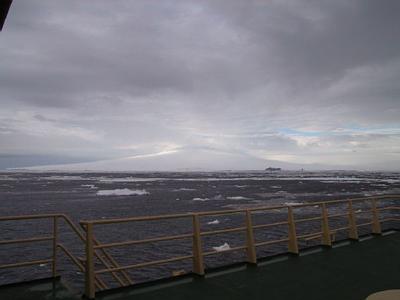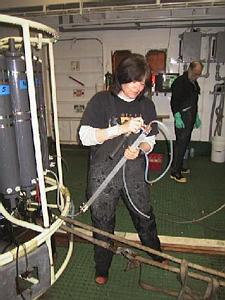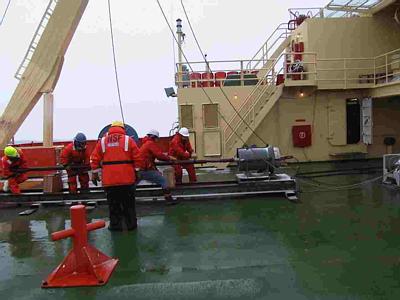
|
|
27 February, 2000
Mud, Mud! Glorious Mud!
73 09 s 126 42 w
Off the north coast of Siple Island
Barometer 975 mb, steady
Temp -2 c (28 F), wind southeast 26 km/hr (16 mph)
Black choppy seas, little pack ice but numerous smaller bergs about
Low clouds
Siple Island coastline occasionally visible through blowing snow
Yesterday afternoon we passed several miles to the west of Mt.
Siple, the snow covered symmetrical volcano that dominates Siple Island. We
headed out to the edge of the continental shelf, more or less following a
glacial trough we discovered. "Stan Jacob's people" took CTDs. The "core
people" took six cores, including one in the middle of the trough out at
the shelf break. The "ice people" watched the ice and tested some repaired
equipment out on deck, and kept their ice observations. The "seal people"
kept watch from the ice tower. The isotope samplers sampled, and Stuart
Klipper took photos. I haven't mentioned Stuart. He is a professional
photographer, and has made numerous trips to Antarctica as part of the
National Science Foundation's Writers and Artists program. I envy his skill
with his large camera.
We've come back to Siple Island in the cold snowy half-light of
dawn. We 're following its coast to the east. Every few minutes, a
heartless black rock formation appears through the snow, and then fades
again into the fog. I've tried to convey to you what it is like here, but I
don't know how well I've succeeded. If you can find some of Stuart
Klipper's or Eliot Porter's photos in a library, maybe you can get a better
idea.
Yesterday afternoon, it was much brighter and the visibility was
better. The picture of Mount Siple with this journal entry was taken then.
As with everything in Antarctica, it's hard to get a good idea of its size,
especially from the picture. Think of it as a little less than two miles
high. That would make the base five or six miles across, as you see it in
the picture. From the ship, it didn't look all that big, more like a fair
sized hill one could climb in an hour or so. I don't know if anybody has
ever climbed it. As with most of this coastline, it was first mapped in the
1940s. It wasn't until 1962 that Siple Island, seventy miles long, was
recognized as an island and named. Incidentally, there's a long i in Siple,
pronounced as the i in the word ice.
Who was Siple, to get this huge volcano named after him? Paul
Siple is a legend in Antarctic history. Originally, he came to the
continent with one of Richard Byrd's expeditions. There are many stories
told about him. He was chosen to come with Byrd through a Boy Scout essay
contest. The essay topic was "Why I want to go to Antarctica." It is said
that the five finalists in the contest met before the judging, and in the
course of a few hours, they all knew that Paul Siple was going to be the
one chosen. His first winter here was another result of his Boy Scout
activities. The expedition's taxidermist had to leave at the end of the
summer for medical reasons, and Paul Siple had a merit badge in taxidermy,
so he was chosen as the replacement.
Yesterday I was busy all day helping take cores. Some of them
worked, and some of them did not. I've been talking a lot about cores and
mud, and have shown you a picture or two. I'd like to explain some more
about mud and coring, starting with a little review of the equipment I've
seen used here.
We've been using two different coring systems. The first is called
the Kasten corer. There is a picture of me with the Kasten corer in my
February 25th journal entry. The Kasten corer is just a long, square tube
with weights on the top. The box is 14 cm (5 in.) square and 3 m (9.8 ft.)
long. It is lowered down on a cable, and then allowed to fall into the
bottom. There are a couple of metal doors on the bottom which open up and
let the mud in. When the corer is pulled back out, they close so the sample
won't fall out. Once the corer is back on ship, you can unscrew some tiny
cold screws and take one side of the box off. If all goes well, the box is
full of nicely layered sediment. You can see some mud (but not much) in the
picture.
The other kind of corer I've been helping with is called a piston
corer. If you look in my February 24 journal entry you can see a picture of
the top part of the piston corer. The 4.5 m (15 ft.) core pipe is hanging
down in the water, out of sight. The piston corer and the Kasten corer have
the same general idea: a heavy tube drops into the mud, and brings the
sample back on ship. The piston corer is a little more complicated, though.
It has another small corer called the trigger core, hanging off the side.
The trigger core hangs a few meters below the bottom of the main corer.
When the trigger core hits bottom, it releases the main corer, which falls
to the bottom and sticks in. As the piston corer goes into the mud, a
piston moves up inside the pipe. The mud is forced up from the bottom by
the falling core, and sucked from the top by the piston. In the bottom of
the pipe there is a thing called a core catcher that keeps the mud in the
pipe when it's pulled out. When all goes well, the piston corer brings up a
long section of the bottom mud, plus a smaller trigger core. Unlike the
Kasten corer, you can't open up the pipe and look at the mud. The core
comes out in a plastic core liner, a transparent tube 7 cm (2.75 in.) in
diameter, and as long as the metal pipe.
The Nathaniel B. Palmer has people who are experts at using the
corers. Jesse Doren, Alice Doyle, Dave Green, Steve Ager and Christian
McDonald really know what they are doing when it comes to working safely on
deck with this heavy, complicated machinery. Sometimes, though, things just
don't go right, and the corers come up empty or nearly so. Maybe the corer
hits the bottom and falls over, or it goes in a little way and hits a hard
layer and stops, or the doors on the bottom don't close and the core washes
out on the way up. Sometimes a big rock will get stuck in the core catcher
and keep mud from getting in. Whatever the cause, you just have to grin and
bear it, and try again!
When several cores in a row come up empty, we've joked about
throwing coins, pocket knives or food offerings overboard as a sacrifice to
Neptune, the god of the deep sea. Presumably he tends to cores also!
(An hour later) As I had finished the above and was about to send
it, we arrived "on station" off Siple Island, to take a core. Neptune must
have been happy, because we got about eight feet of nice mud, although the
trigger core came up empty.
What we do with the mud, what we look for when we get it, is more
important than how we get it. I'm all set to go climb in my bunk now, so
I'll continue the story tomorrow.

Mount Siple's 3000 m (9840 ft) summit is hidden in the clouds. The two black rocks on its lower right flank are old volcanic necks. There the lava hardened in the "pipes," and then the ash cones eroded away.

Dee Breger, an expert electron microscopist from Lamont Observatory, samples CTD bottles for helium. The strap in front of her knees keeps the CTD from sliding around in heavy seas. The copper tube I talked about in my February 25 journal is mounted in the long thin tray in her left hand.

Sometimes it's easy to get the piston corer apart to get the sample. Other times, it's not so easy.
Contact the TEA in the field at
.
If you cannot connect through your browser, copy the
TEA's e-mail address in the "To:" line of
your favorite e-mail package.
|
